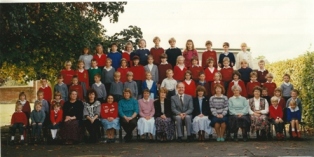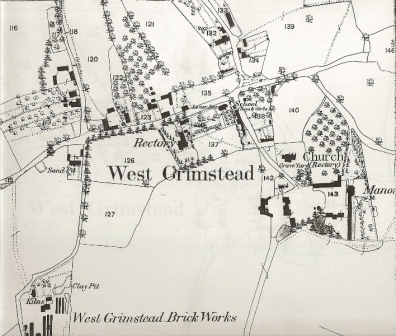|
|
|

The final photograph taken of pupils and Staff before the old West
Grimstead school closed in December 1992.
..................................................
In 1984 the Head Teacher of WG Primary School took the
children who were in their last year on a 4 day field trip to the Brecon Beacons
in Wales.The Head Teacher was Mr Alan Lygo-Baker and he did a write-up of the
trip. You can see it
HERE
A second trip was taken in 1987
|
|
HISTORY
OF WEST GRIMSTEAD PRIMARY SCHOOL 1830 - 1993
The
first mention of a school in West Grimstead that I have found is in a document
concerning Thomas Light (a family ancestor). The document is dated 1831. Thomas
Light was convicted of Machine Breaking during the Swing Riots of 1830. The
document describes Thomas as follows: 'Married, 4 children, wife Martha ...
keeps a school West Grimstead'

Records
at Wiltshire and Swindon History Centre tell that there was a day school
in 1839 where children were admitted at 4 years old and stayed until the age of 12 years. In that year there were 13 boys
and 18 girls attending. It would have been housed either in the curate’s house
or in a cottage where the teacher lived and was maintained by the rector who
contributed £6 a year. The scholars paid one penny a week to attend. It is
thought some children from the parish attended the school at Farley, which had a
successful Sunday school with over 50 pupils.
A schoolroom for 60 children at Grimstead was built in 1856; the Diocesan
Committee of the Council on Education contributed £101 and it was built on glebe land
near to the parsonage. By 1859, this school catered for between 30 and 40 pupils
in a room with a wooden boarded floor and parallel desks. It was reported that
the discipline was good, the instruction very fair, and that the school was in
good hands. Ellen Batten was schoolmistress at that time and, as there was no
post office in the village, there was a letter receiving box at the school; this
closed at 5.00 p.m. when the letters were taken to Salisbury.
By the end of the 19th century the average attendance was 40 and by 1907 there
were 50 pupils on the register. Attendance at school was regularly affected by
illness and bad weather, as well as the need for children to go out and work in
the fields. For example, the school was shut for a fortnight in May 1884 due to
an outbreak of measles and whooping cough was also a common affliction. The
school was shut for two weeks in 1912 because of Scarlet Fever. The older
children had a propensity to miss school to go and work especially during the
hay harvest, potato planting and picking, or even beating for game shoots.
The reports throughout the years were generally positive and HMI of 1884 wrote:
“The children are well managed, and are making steady progress in the elementary
work. The handwriting has improved and is on the whole fair, though the second
standard should be more careful to shape their letters properly.”
A diocesan inspection in 1906 read: “The children in all classes answered well.
The tone of the school was good, making the examination a pleasure and showing
the children had profited by careful instruction.” In that year Wiltshire County
Council took over the overall responsibility for the school.
His Majesty’s Inspector of 1929 wrote: “This small school is managed in a
capable manner.
The teaching is sympathetic and effective and a creditable level is attained in
nearly all the subjects. The infants are making good progress generally,
although the confined conditions under which they are taught- in the same room
as the older children- limits free movement and vigorous oral teaching.”
In 1938, the school began serving milk to all its pupils under the national milk
scheme and in September 1939, after the outbreak of World War Two, 10 evacuees
were admitted to the school. In 1954 there were 45 pupils attending the school –
West Grimstead was still an all age school – and the building was so small that
when school meals were introduced in 1952 they had to be served in the village
hall; problems with heating the school persisted and two Elsan toilets were the
only means of sanitation for the school. Later the village hall was also used
for teaching but that too had heating problems. By 1955, when 52 children
attended the school, it was proposed that children over the age of 11 should
attend the secondary school at Downton but parents objected as they preferred to
wait for a secondary modern school to be built at Laverstock as this was closer.
By 1958 the school was too small to cope with the number of pupils attending and
a prefabricated building was erected on the other side of the road from the
school. By 1962 there were three classes at the school; infants in the village
hall, Juniors in the prefabricated building, and seniors in the old school. In
September 1962 the seniors (aged 11+) went to the schools at Laverstock and in
1966 a second temporary classroom was built with the use of the village hall
ceasing. By 1969 there were 77 children at the school, but throughout the 1960s
there had been plans to close the Grimstead school and amalgamate it with
Alderbury in a new building in the latter village.
By 1982, 66 children were attending the Grimstead school but this had dropped to
55 in 1991, by which time attendance at Alderbury had risen from 75 to 91. In
January 1993, the school merged with Alderbury School to make Alderbury and West
Grimstead Primary School, and is sited in Alderbury.
Alderbury and West Grimstead School
opened January 1993
|

